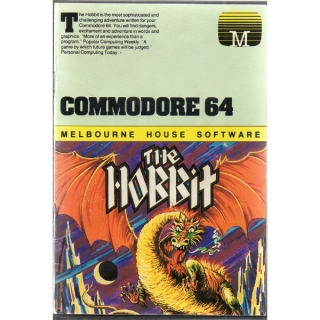THE HOBBIT C64 TAPE
THE HOBBIT C64 TAPE
The Hobbit is an illustrated text adventure computer game released in 1982 and based on the book The Hobbit, by J. R. R. Tolkien. It was developed at Beam Software by Philip Mitchell and Veronika Megler and published by Melbourne House for most home computers available at the time, from more popular models such as the ZX Spectrum, the Commodore 64, Amstrad CPC 464, BBC Micro, MSX, Dragon 32 and Oric. By arrangement with the book publishers, a copy of the book was included with each game sold.
The parser was very advanced for the time and used a subset of English called Inglish.[4][5] When it was released most adventure games used simple verb-noun parsers (allowing for simple phrases like 'get lamp'), but Inglish allowed one to type advanced sentences such as "ask Gandalf about the curious map then take sword and kill troll with it". The parser was complex and intuitive, introducing pronouns, adverbs ("viciously attack the goblin"), punctuation and prepositions and allowing the player to interact with the game world in ways not previously possible.
Many locations are illustrated by an image, based on originals designed by Kent Rees. On the tape version, to save space, each image was stored in a compressed format by storing outline information and then flood filling the enclosed areas on the screen The slow CPU speed meant that it would take up to several seconds for each scene to draw. The disk-based versions of the game used pre-rendered, higher-quality images.
The game has an innovative text-based physics system, developed by Veronika Megler. Objects, including the characters in the game, have a calculated size, weight and solidity. Objects can be placed inside other objects, attached together with rope and damaged or broken. If the main character is sitting in a barrel and this barrel is then picked up and thrown through a trapdoor, the player would go through.
Unlike other works of interactive fiction, the game is also in real time, insofar as a period of idleness causes the "WAIT" command to be automatically invoked and the possibility of events occurring as a result. This can be suppressed by entering the "PAUSE" command, which stops all events until a key is pressed.
The game has a cast of non-player characters (NPCs) entirely independent of the player and bound to precisely the same game rules. They have loyalties, strengths and personalities that affect their behaviour and cannot always be predicted. The character of Gandalf, for example, would roam freely around the game world (some fifty locations), picking up objects, getting into fights and being captured.
The volatility of the characters, coupled with the rich physics and impossible-to-predict fighting system, enabled the game to be played in many different ways, though this would also lead to problems (such as an important character being killed early on). There are numerous possible solutions and with hindsight the game might be regarded as one of the first examples of 'emergent gaming'. This also resulted, however, in many bugs; for example, during development Megler found that the animal NPCs killed each other before the player arrived. The game's documentation warned that "Due to the immense size and complexity of this game it is impossible to guarantee that it will ever be completely error-free". Melbourne House issued a version 1.1 with some fixes, but with another bug that resulted in the game being unwinnable, forcing it to release version 1.2, and the company never fixed all bugs
KOMPLETT I BOX - SAKNAR FRAMSIDA - BILD ÄR FRÅN MANUALEN


